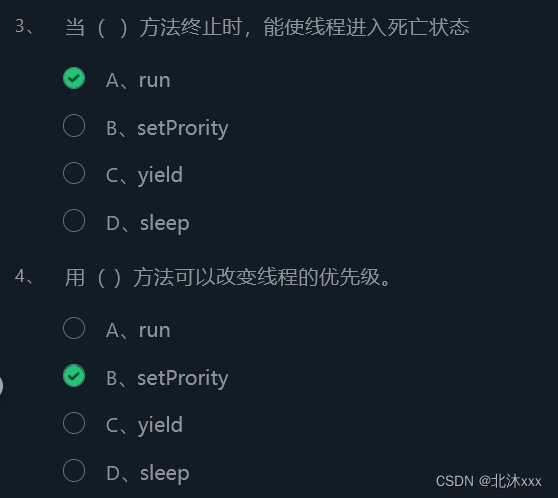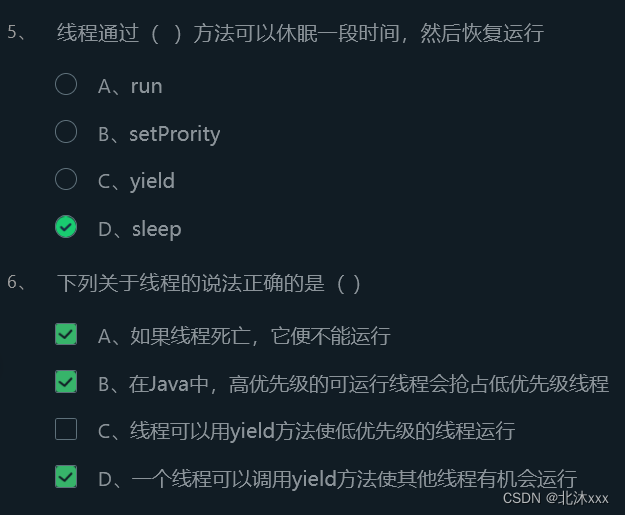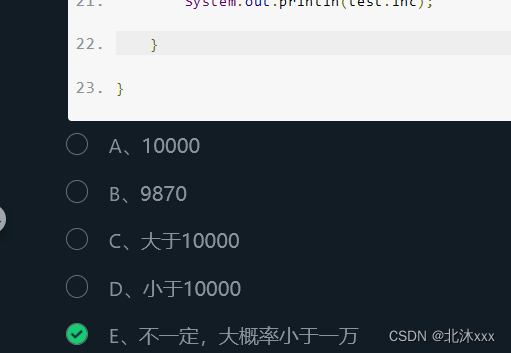Table of contents
Java Advanced Features - Multithreading Basics (1) Using Threads
Level 2: Create threads using Callable and Future
Java Advanced Features - Multithreading Basics (2) Common Functions
Level 1: Thread status and schedulingEdit
Level 2: Commonly used functions (1)
Level 3: Commonly used functions (2)
Java Advanced Features - Multi-Threading Basics (3) Thread Synchronization
Level 1: Three concepts of concurrent programmingEdit
Level 2: Synchronize threads using the synchronized keyword
Level 3: Using thread lock (Lock) to achieve thread synchronization
Level 4: Using volatile to achieve variable visibility
Java Advanced Features-Multi-Threading Exercises
Java Advanced Features - Multithreading Basics (1) Using Threads
Level 1: Create a thread
package step1;
//请在此添加实现代码
/********** Begin **********/
public class ThreadClassOne extends Thread {
public int i=0;
public ThreadClassOne(){
super();
}
public void run(){
for(i=0;i<10;i++){
if(i%2==1)
System.out.print(i+" ");
}
}
}
/********** End **********/
Level 2: Create threads using Callable and Future
package step2;
import java.util.concurrent.Callable;
import java.util.concurrent.FutureTask;
public class Task {
public void runThread(int num) {
//请在此添加实现代码
/********** Begin **********/
// 在这里开启线程 获取线程执行的结果
Callable callable = new ThreadCallable(num);
FutureTask<Integer> futureTask = new FutureTask<>(callable);
new Thread(futureTask).start();//开启线程
try {
Integer result = futureTask.get();
System.out.println("线程的返回值为:" + result);
} catch (Exception e) {
e.printStackTrace();
}
/********** End **********/
}
}
//请在此添加实现代码
/********** Begin **********/
/* 在这里实现Callable接口及方法 */
class ThreadCallable implements Callable<Integer>{
private int num;
public ThreadCallable() {
}
public ThreadCallable(int num) {
this.num = num;
}
public Integer call() throws Exception {
int[] arr = new int[2];
arr[0] = 1;
arr[1] = 1;
for (int i = 2; i < num; i++) {
int tmp = arr[1];
arr[1] = arr[0] + arr[1];
arr[0] = tmp;
}
return arr[1];
}
}
/********** End **********/
Java Advanced Features - Multithreading Basics (2) Common Functions
Level 1: Thread status and scheduling


Level 2: Commonly used functions (1)
package step2;
import java.util.Scanner;
public class Task {
public static void main(String[] args) {
Scanner sc = new Scanner(System.in);
int num = sc.nextInt();
//请在此添加实现代码
/********** Begin **********/
Thread t = new MyThread("子线程",num);
t.start();
/********** End **********/
}
}
//请在此添加实现代码
/********** Begin **********/
class MyThread extends Thread{
private int num;
private String name;
public MyThread(String name,int num){
this.num=num;
this.name=name;
}
public void run(){
int[] arr = new int[2];
arr[0] = 1;
arr[1] = 1;
for (int i = 2; i < num; i++) {
int tmp = arr[1];
arr[1] = arr[0] + arr[1];
arr[0] = tmp;
}
System.out.println("子线程计算结果为:"+arr[1]);
}
}
/********** End **********/
Level 3: Commonly used functions (2)
package step3;
public class MyThread implements Runnable {
//请在此添加实现代码
/********** Begin **********/
private String name;
private Object prev;
private Object self;
private MyThread(String name,Object prev,Object self){
this.name = name;
this.prev = prev;
this.self = self;
}
public void run(){
int count = 5;
while(count>0){
synchronized(prev){
synchronized(self){
System.out.print(name);
count--;
self.notify();
}
try {
prev.wait();
} catch (InterruptedException e) {
e.printStackTrace();
}
}
}
System.exit(0);
}
public static void main(String[] args) throws Exception {
Object a = new Object();
Object b = new Object();
Object c = new Object();
MyThread ta = new MyThread("E",c,a);
MyThread tb = new MyThread("D",a,b);
MyThread tc = new MyThread("U",b,c);
new Thread(ta).start();
Thread.sleep(100);
new Thread(tb).start();
Thread.sleep(100);
new Thread(tc).start();
Thread.sleep(100);
}
/********** End **********/
}
Java Advanced Features - Multi-Threading Basics (3) Thread Synchronization
Level 1: Three concepts of concurrent programming

Level 2: Synchronize threads using the synchronized keyword
package step2;
public class Task {
public static void main(String[] args) {
final insertData insert = new insertData();
for (int i = 0; i < 3; i++) {
new Thread(new Runnable() {
public void run() {
insert.insert(Thread.currentThread());
}
}).start();
}
}
}
class insertData{
public static int num =0;
/********* Begin *********/
public synchronized void insert(Thread thread){
for (int i = 0; i <= 5; i++) {
num++;
System.out.println(num);
}
}
/********* End *********/
}
Level 3: Using thread lock (Lock) to achieve thread synchronization
package step3;
import java.util.concurrent.TimeUnit;
import java.util.concurrent.locks.Lock;
import java.util.concurrent.locks.ReentrantLock;
public class Task {
public static void main(String[] args) throws InterruptedException {
final Insert insert = new Insert();
Thread t1 = new Thread(new Runnable() {
public void run() {
insert.insert(Thread.currentThread());
}
});
Thread t2 = new Thread(new Runnable() {
public void run() {
insert.insert(Thread.currentThread());
}
});
Thread t3 = new Thread(new Runnable() {
public void run() {
insert.insert(Thread.currentThread());
}
});
// 设置线程优先级
/*
t1.setPriority(Thread.MAX_PRIORITY);
t2.setPriority(Thread.NORM_PRIORITY);
t3.setPriority(Thread.MIN_PRIORITY);
t1.start();
t2.start();
t3.start();
*/
t1.start();
t2.sleep(500);
t2.start();
t3.sleep(1000);
t3.start();
}
}
class Insert {
public static int num;
// 在这里定义Lock
private Lock lock = new ReentrantLock();
public void insert(Thread thread) {
/********* Begin *********/
if (lock.tryLock()) {
try {
System.out.println(thread.getName() + "得到了锁");
for (int i = 0; i < 5; i++) {
num++;
System.out.println(num);
}
} finally {
System.out.println(thread.getName() + "释放了锁");
lock.unlock();
}
} else {
System.out.println(thread.getName() + "获取锁失败");
}
}
/********* End *********/
}
Level 4: Using volatile to achieve variable visibility
package step4;
public class Task {
public volatile int inc = 0;
//请在此添加实现代码
/********** Begin **********/
public synchronized void increase() {
inc++;
}
/********** End **********/
public static void main(String[] args) {
final Task test = new Task();
for (int i = 0; i < 10; i++) {
new Thread() {
public void run() {
for (int j = 0; j < 1000; j++)
test.increase();
};
}.start();
}
while (Thread.activeCount() > 1) // 保证前面的线程都执行完
Thread.yield();
System.out.println(test.inc);
}
}
Java Advanced Features-Multi-Threading Exercises
Level 1: Sequential output
package step1;
public class Task {
public static void main(String[] args) throws Exception {
/********* Begin *********/
//在这里创建线程, 开启线程
Object a = new Object();
Object b = new Object();
Object c = new Object();
MyThread ta = new MyThread("A",c,a);
MyThread tb = new MyThread("B",a,b);
MyThread tc = new MyThread("C",b,c);
ta.start();
ta.sleep(100);
tb.start();
tb.sleep(100);
tc.start();
tc.sleep(100);
/********* End *********/
}
}
class MyThread extends Thread {
/********* Begin *********/
private String threadName;
private Object prev;
private Object self;
public MyThread(String name,Object prev,Object self){
this.threadName = name;
this.prev = prev;
this.self = self;
}
public void run() {
int count = 5;
while(count>0){
synchronized(prev){
synchronized(self){
System.out.println("Java Thread"+this.threadName+this.threadName);
count--;
self.notify();
}
try {
prev.wait();
} catch (InterruptedException e) {
e.printStackTrace();
}
}
}
System.exit(0);
}
/********* End *********/
}
Level 2: Ticket Window
package step2;
/********* Begin *********/
//定义站台类,实现卖票的功能。
public class Station extends Thread{
static int tick = 20; // 为了保持票数的一致,票数要静态
static Object ob = new Object(); // 创建一个静态钥匙 值是任意的
public void ticket() {
System.out.println( "卖出了第" + tick + "张票");
tick--;
}
public void run() {
while (tick > 0) {
synchronized (ob) {
if (tick > 0) {
ticket();
}
}
if(tick == 0){
System.out.println("票卖完了");
}
try {
Thread.sleep(100);
} catch (Exception e) {
}
}
}
}
/********* End *********/